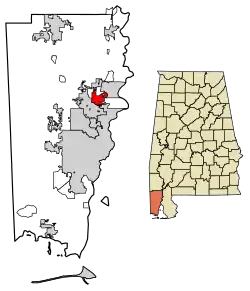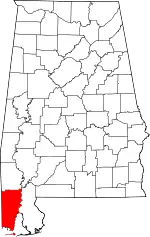Satsuma, Alabama
Satsuma is a city in Mobile County, Alabama, United States. At the 2010 census the population was 6,168. Known prior to 1915 as Fig Tree Island, the city was named after the Satsuma orange, which was successfully cultivated and grown in Alabama starting in 1878, a gift from Emperor Meiji of Japan. Satsuma is a part of the Mobile metropolitan statistical area.
Satsuma | |
|---|---|
| Motto(s): "Enjoy Quality of Life in Satsuma" | |
 Location of Satsuma in Mobile County, Alabama. | |
| Coordinates: 30°51′16″N 88°3′16″W | |
| Country | United States |
| State | Alabama |
| County | Mobile |
| Area | |
| • Total | 7.38 sq mi (19.12 km2) |
| • Land | 7.33 sq mi (19.00 km2) |
| • Water | 0.05 sq mi (0.12 km2) |
| Elevation | 13 ft (4 m) |
| Population (2010) | |
| • Total | 6,168 |
| • Estimate (2019)[2] | 6,190 |
| • Density | 844.01/sq mi (325.87/km2) |
| Time zone | UTC-6 (Central (CST)) |
| • Summer (DST) | UTC-5 (CDT) |
| ZIP code | 36572 |
| Area code(s) | 251 |
| FIPS code | 01-68352 |
| GNIS feature ID | 0126426 |
| Website | http://www.cityofsatsuma.com/ |
History
The area was inhabited for thousands of years by differing cultures of indigenous peoples.
- 1878 Farmers introduced Mandarin Satsuma oranges to Alabama from Japan for cultivation
- 1900 Satsuma area known as Fig Tree Island
- 1910 Pace Orange Orchard had about 100 acres (0.40 km2) of pecans and satsuma trees on the area
- 1915 Town named "Satsuma"
- 1918 Mr. Norman E. McConaghy hired as manager of the Satsuma Orange & Pecan Groves Company.
- 1922 Packing house built; still stands above Mac's Landing
- 1912-1924 Satsuma trees damaged by cold weather and citrus canker
- 1959 Plans for a Town Charter submitted to the County of Mobile and the State of Alabama were approved. April 6, 1959 was the first municipal election.
Geography
According to the U.S. Census Bureau, the city has a total area of 6.5 square miles (17 km2), of which 6.5 square miles (17 km2) is land and 0.15% is water.
Demographics
| Historical population | |||
|---|---|---|---|
| Census | Pop. | %± | |
| 1960 | 1,491 | — | |
| 1970 | 2,035 | 36.5% | |
| 1980 | 3,822 | 87.8% | |
| 1990 | 5,194 | 35.9% | |
| 2000 | 5,687 | 9.5% | |
| 2010 | 6,168 | 8.5% | |
| 2019 (est.) | 6,190 | [2] | 0.4% |
| U.S. Decennial Census[3] 2013 Estimate[4] | |||
At the 2000 census there were 5,687 people in 2,017 households, including 1,688 families, in the city. The population density was 873.1 people per square mile (337.3/km2). There were 2,107 housing units at an average density of 323.5 per square mile (125.0/km2). The racial makeup of the city was 93.72% White, 5.05% Black or African American, 0.55% Native American, 0.25% Asian, 0.16% from other races, and 0.28% from two or more races. 0.58% of the population were Hispanic or Latino of any race.[5] Of the 2,017 households 37.5% had children under the age of 18 living with them, 71.3% were married couples living together, 8.9% had a female householder with no husband present, and 16.3% were non-families. 14.8% of households were one person and 6.8% were one person aged 65 or older. The average household size was 2.81 and the average family size was 3.10.
The age distribution was 26.0% under the age of 18, 8.3% from 18 to 24, 28.0% from 25 to 44, 26.5% from 45 to 64, and 11.2% 65 or older. The median age was 38 years. For every 100 females, there were 96.2 males. For every 100 females age 18 and over, there were 91.3 males.
The median household income was $50,496 and the median family income was $53,180. Males had a median income of $39,123 versus $24,851 for females. The per capita income for the city was $23,972. About 4.7% of families and 6.0% of the population were below the poverty line, including 8.0% of those under age 18 and 10.9% of those age 65 or over.
2010 census
At the 2010 census there were 6,168 people in 2,290 households, including 1,774 families, in the city. The population density was 948.9 people per square mile (365.0/km2). There were 2,416 housing units at an average density of 371.7 per square mile (143.0/km2). The racial makeup of the city was 88.7% White, 7.9% Black or African American, 1.2% Native American, 0.6% Asian, 0.4% from other races, and 1.1% from two or more races. 1.1% of the population were Hispanic or Latino of any race.[6] Of the 2,290 households 31.0% had children under the age of 18 living with them, 61.8% were married couples living together, 11.5% had a female householder with no husband present, and 22.5% were non-families. 18.8% of households were one person and 8.7% were one person aged 65 or older. The average household size was 2.67 and the average family size was 3.05.
The age distribution was 23.8% under the age of 18, 7.5% from 18 to 24, 24.4% from 25 to 44, 29.4% from 45 to 64, and 14.9% 65 or older. The median age was 40.7 years. For every 100 females, there were 93.2 males. For every 100 females age 18 and over, there were 94.8 males.
The median household income was $59,289 and the median family income was $63,333. Males had a median income of $46,938 versus $33,791 for females. The per capita income for the city was $25,087. About 0% of families and 0.7% of the population were below the poverty line, including 0% of those under age 18 and 1.5% of those age 65 or over.
Education
Satsuma is served by the Satsuma City School System, following the successful separation from the Mobile County Public School System in 2012.
Satsuma voted on April 12, 2011 to create its own school system.[7] The Satsuma City School System is served by two schools, Robert E. Lee Elementary (K-6) and Satsuma High School (7-12).
Education before the Separation from Mobile
Before the Satsuma City School System was founded, the schools that served Satsuma included Robert E. Lee Primary School (Kindergarten through 2), Robert E. Lee Intermediate School (3 through 5), North Mobile County Middle School (6-8), Satsuma High School (9-12). Lee Primary, Lee Intermediate, and Satsuma High were in the city of Satsuma, while North Mobile County Middle was in Axis.[8]
Before the Saraland City Schools system formed, Satsuma residents attended Adams Middle School in Saraland. In 2003,[8] officials of Satsuma, Saraland, and Chickasaw contemplated forming the "Delta School District."[9] Such a split would have required an act from the Alabama Legislature.[8] In June 2006, the City of Saraland voted to break away from the Mobile County Public School System and form its own school system.[10] On September 7, 2010 North Mobile County Middle School opened, replacing the role of Adams Middle School in Saraland, because residents outside of Saraland are no longer zoned to Adams Middle.[11]
Satsuma residents considered leaving Mobile County schools since circa 2001.[12] In 2010, the City of Satsuma began conducting a study on whether it can split from the Mobile County school system. Tom Williams, a council member of Satsuma, said he began considering splitting once Mobile County decided to situate the new middle school in Axis, 12 miles (19 km) from Satsuma, since students have longer bus rides to the school and that the school is further away from fire and police stations.[8] The Mobile County government built the school outside of the Satsuma city limits so the city government would be unable to possess the school if it opted to secede.[12]
References
- "2019 U.S. Gazetteer Files". United States Census Bureau. Retrieved June 29, 2020.
- "Population and Housing Unit Estimates". United States Census Bureau. May 24, 2020. Retrieved May 27, 2020.
- "U.S. Decennial Census". Census.gov. Retrieved June 6, 2013.
- "Annual Estimates of the Resident Population: April 1, 2010 to July 1, 2013". Retrieved June 3, 2014.
- "U.S. Census website". United States Census Bureau. Retrieved 2008-01-31.
- "U.S. Census website". United States Census Bureau. Retrieved 2015-08-04.
- Busby, Renee. "Satsuma residents approve tax for new public school system". Press-Register.
- Phillips, Rena Havner. "Satsuma mulls split from Mobile County schools." Mobile Press-Register. Tuesday October 5, 2010. Retrieved on October 22, 2010.
- Philips, Rena Havner. "Chickasaw officials to examine possible school split", Mobile Press-Register. 27 March 2009, . Retrieved on March 31, 2009
- "Education." Saraland Chamber of Commerce. Retrieved on October 22, 2010.
- Phillips, Rena Havner. "Video: North Mobile County Middle School opens its doors in Axis." Mobile Press-Register. Tuesday September 7, 2010. Retrieved on October 22, 2010. "North Mobile County Middle School students 6th grader Derrick Boykin, 12, and 7th grader Amanda Daniels, 12, walk down a sidewalk on the first day of classes at the school Tuesday, Sept. 7, 2010. The newly completed $14 million school was built to accommodate students displaced by Saraland's split from the Mobile County system. "
- Havner, Rena. "School distance key issue in proposed Satsuma split from Mobile public schools." AL.com. January 24, 2011. Retrieved on June 14, 2016.
